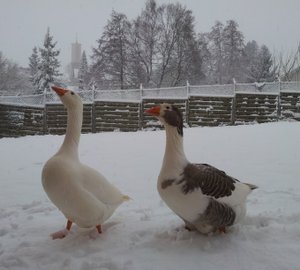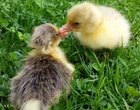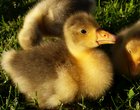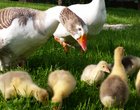Geese.ch
West of England Gänse
AN ANCIENT BREED
Auto-sexing geese have been recorded in Devon and Cornwall for centuries as the 'Common Goose'. There is a picture from 1854 that appears to show the breed. They certainly were exhibited at shows from the 1970s, but the West of England breed was only standardised in 1999 by the British Waterfowl Association.
The Pilgrim goose is also autosexing, and is found in the UK, continental Europe, the US, and Australia. The Pilgrim female is pale grey all over apart from white 'spectacles', while the West of England female has a clear saddleback pattern.
The Normandy goose in France and the Shetland goose are very similar but much smaller. The Cotton Patch goose in the US is a smaller, lighter auto-sexing breed which has both a saddleback and a full-grey variant. The 'Old English' goose in the US may be very much like the West of England, although we have been unable to find out very much about it. There are also reports of autosexing saddleback geese from Australia.
Although the saddleback gene is common in geese, not all geese that look like this are autosexing. This is a major problem for breeders, because it is hard to be sure that geese offered for sale will produce auto-sexing offspring.




